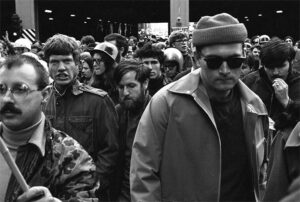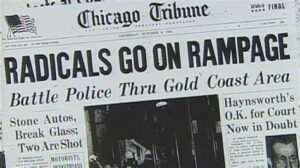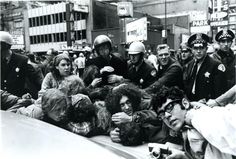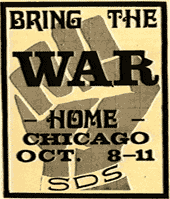
 In the late 1960s, Chicago was engulfed in turmoil. The assassination of Martin Luther King Jr. on April 4, 1968, sparked riots throughout the United States, leaving Chicago’s West Side in ruins. Mayor Richard J Daley infamously ordered a “shoot to kill” directive for arsonists. It was a vast difference from the way riots were handled in the 2020 era, after the killing of George Floyd, when riots were not only allowed, but encouraged. Nevertheless, in Chicago in 1968, chaos reigned then and again during the Democratic National Convention a few months later, culminating in a confrontation between protesters and police that a national commission later described as a “police riot.”
In the late 1960s, Chicago was engulfed in turmoil. The assassination of Martin Luther King Jr. on April 4, 1968, sparked riots throughout the United States, leaving Chicago’s West Side in ruins. Mayor Richard J Daley infamously ordered a “shoot to kill” directive for arsonists. It was a vast difference from the way riots were handled in the 2020 era, after the killing of George Floyd, when riots were not only allowed, but encouraged. Nevertheless, in Chicago in 1968, chaos reigned then and again during the Democratic National Convention a few months later, culminating in a confrontation between protesters and police that a national commission later described as a “police riot.”
The year 1969 seemed to mark a period of calm until the commencement of a conspiracy trial targeting the Democratic convention protest organizers, which ignited a new phase in the clash between the counterculture and the “establishment.” This battle shifted from the streets to the realm of public opinion. While the defendants attempted to mock and censure the government, represented by Judge Julius Hoffman in the courtroom, a separate faction of youth chose to take a more extreme stance in protesting the government and the ongoing Vietnam conflict. Their strategy was to “bring the war home” through four “Days of Rage.” It amazes me that these people think that destroying their own “home turf” and the businesses that are there, would somehow generate support for their cause…and then they want the American people to pay for the repairs!!
“Every day that the war [in Vietnam] went on, two thousand innocent people would be killed. So, there was a kind of urgency that took over. And in that context, we faced each other and tried to figure out, what do you do to end a war? How do you stop it,” Bill Ayers, an organizer of the Days of Rage, told WTTW decades later. Ayers and his fellow protesters belonged to the activist group Students for a Democratic Society but were starting to diverge from the main SDS body. They named themselves the Weathermen, inspired by a lyric in a Bob Dylan song, “Subterranean Homesick Blues” which stated, “You don’t need a weather man to know which way the wind blows.”
The Weathermen believed that the peaceful methods of other SDS factions were ineffective, so they organized for thousands to converge on Chicago, coinciding with the commencement of the Chicago Eight conspiracy trial two weeks later. “A huge outpouring of militance, of young people. We felt that we ought to call a demonstration in which we weren’t contained and controlled,” Ayers said. However, as the Days of Rage commenced, the Weathermen discovered their support was significantly less than anticipated. On October 8, 1969, they assembled in Lincoln Park to initiate their violent protests—donning football helmets and shoulder pads, and arming themselves with steel pipes, chains, slingshots, and baseball bats—yet only a few hundred individuals participated, a stark contrast to the fifty thousand they had expected.
On that initial evening in 1969, protesters headed south toward the Drake Hotel, the residence of Judge Hoffman, shattering the windows of vehicles and shops in their path. Following their assault on police barricades, law enforcement quelled the disturbances with countermeasures, deploying tear gas, nightsticks, and firearms. Although some Weathermen were shot and officers sustained injuries, there were no fatalities. “The thought of the Chicago Police Department and the mayor of the city of Chicago was to try to avoid confrontation,” Richard Elrod, a state legislator and attorney for the city who had been tasked with handling the riots, told WTTW decades later. Ayers disagreed, saying, “I don’t think the police, or the city learned a thing between ’68 and ’69.” The police faced widespread criticism for their management of the protests at the Democratic convention the previous year.
Other activists criticized the tactics of the Weathermen. “We thought it was off the wall,” Carl Davidson, a leader of SDS, told WTTW. “We thought it was silly, counterproductive, that it wasn’t going anywhere. That’s the best we thought of it.” A different branch of SDS coordinated peaceful protests with the Black Panthers against the Vietnam War and persistent racial inequality, attracting thousands of participants. However, it was the minor yet violent actions of the Weathermen that captured media attention. Even Ayers later expressed doubt about the riots, saying “I don’t think that the Days of Rage was a particularly smart or effective tactic. I think it was a very difficult time to know what to do, but we were determined to see through our strategy of militant opposition and trying to mobilize all of the militants to come to Chicago to display their anger, their outrage, and their deep opposition to this war. That was a colossal failure, in the sense that we didn’t mobilize lots of people to come.”
The subsequent Days of Rage were less intense, yet on October 11, the Weathermen gathered at a statue of a policeman they had previously bombed in the lead-up to the Days of Rage and proceeded into the Loop. They once again engaged with the police, an event described in a 1994 retrospective article by the Chicago Tribune as a “vicious melee that resulted in nearly 300 arrests, 48 police injuries and unknown more to protesters.” In the midst of the confrontation, Richard Elrod sustained a neck injury that resulted in paralysis from the neck down, although he later regained some movement but continued to suffer partial paralysis. Elrod reported that he had attempted to tackle Brian Flanagan, a 22-year-old protester, who retaliated by kicking him in the neck with steel-toed boots. Flanagan, who was ultimately acquitted on all counts, contended that Elrod collided with a concrete wall during his attempted tackle. The subsequent year, Elrod was elected as the Cook County sheriff and subsequently ascended to the position of a Circuit Court judge.
Former state legislator and Cook County sheriff Richard Elrod, who is shown in a photo from the early 2000s, suffered a broken neck during the Days of Rage. That confrontation marked the end of the Days of Rage. The Weathermen, in certain respects, “brought the war home.” However, their protests might have inadvertently enhanced the police’s reputation and undermined the causes they supported by linking anti-war and anti-racism demonstrations with violence in public perception. Following the Days of Rage, a lengthy magazine feature overtly supportive of the police and the city appeared in the Chicago Tribune, which asserted that “the police, widely condemned scarcely a year ago for their conduct during the Democratic convention, had never enjoyed so much public acclaim.”
Months later, the Weathermen were forced underground when a bomb they were constructing inadvertently detonated, killing three of their leaders in New York City. In the following decades, participants of the Days of Rage began to turn themselves in to the authorities. One of the last to do so was Jeffrey David Powell, who surrendered in 1994 and was sentenced to a fine and 18 months of probation. Ayers, along with his wife Bernardine Dohrn, another member of the Weathermen, surrendered in 1981. While Dohrn was fined and placed on probation, charges against Ayers, whose father was a president at Commonwealth Edison, were dismissed due to illicit FBI methods used against him. He went on to become a professor at the University of Illinois at Chicago and gained brief national attention during the 2008 presidential election for his association with Barack Obama. Dohrn secured a position as a professor at the Children and Family Justice Center at Northwestern University’s Law School. 

The Days of Rage had receded into the annals of history. However, as reported by the Chicago Tribune at the time of Powell’s surrender, “the Days of Rage symbolized a marked fissure in American society, the end of the carefree ‘60s, when rich, white college kids clashed with police, their parents, the government in protest against the Vietnam War, racial intolerance and just about everything else that had served as the status quo.”


One Response to Rage Riots